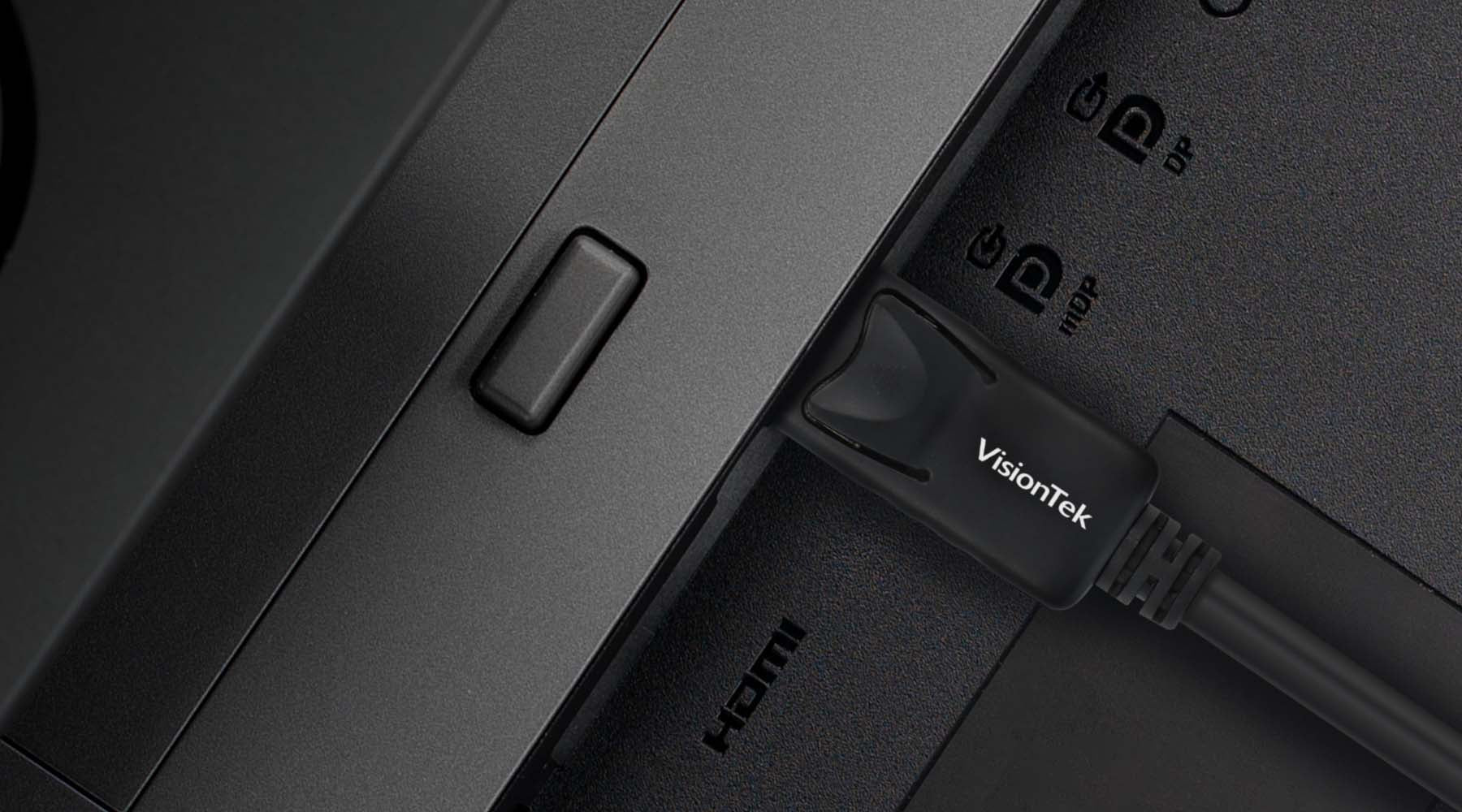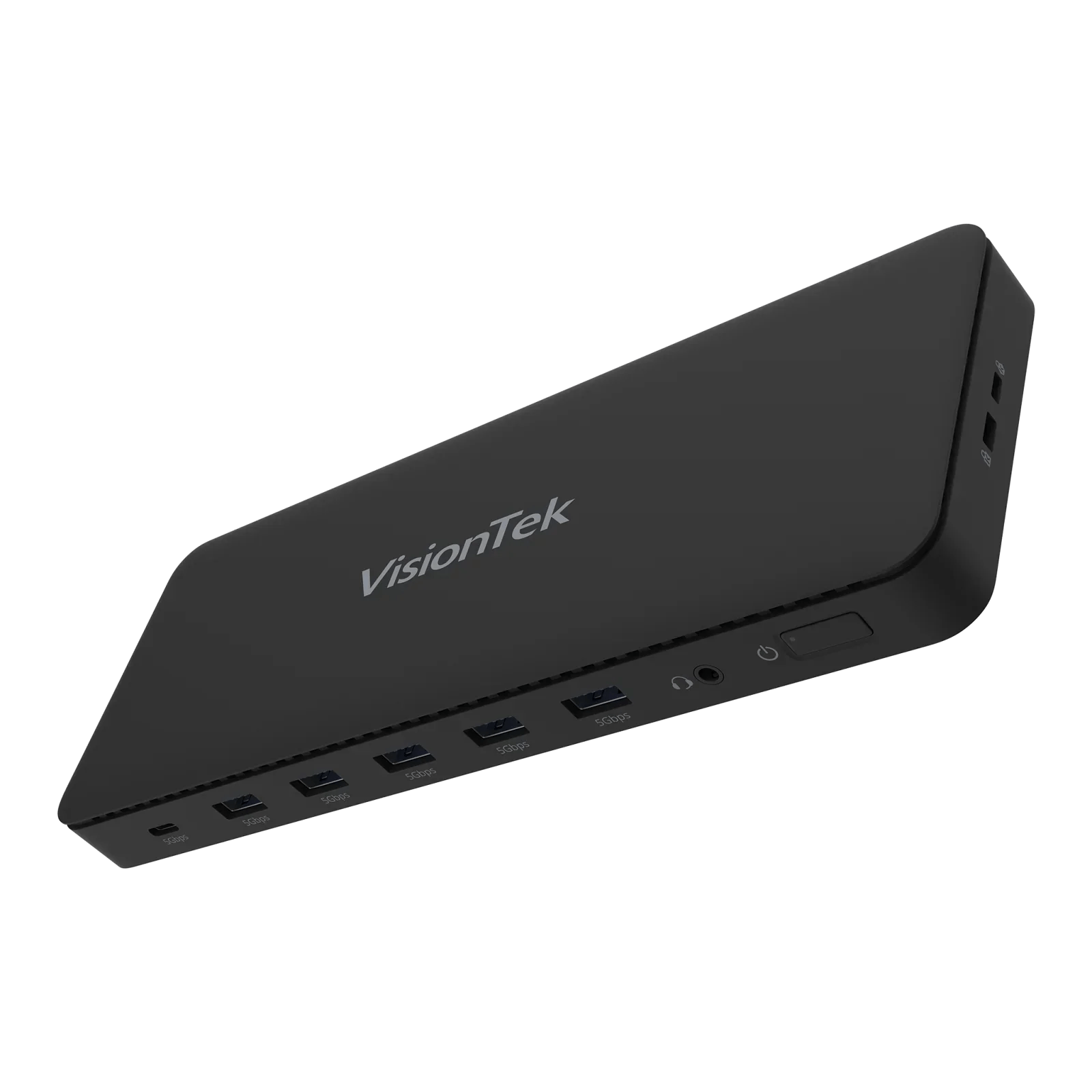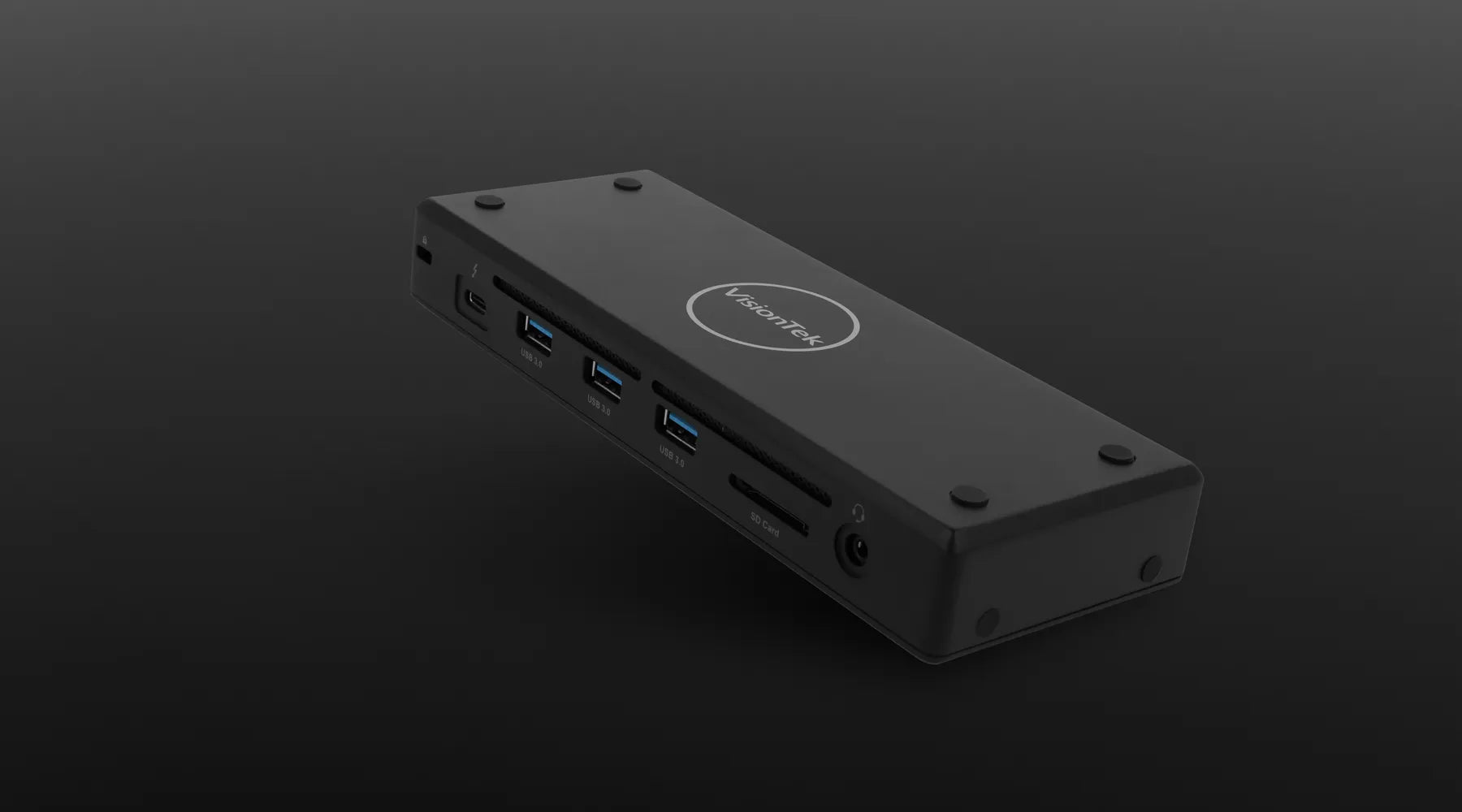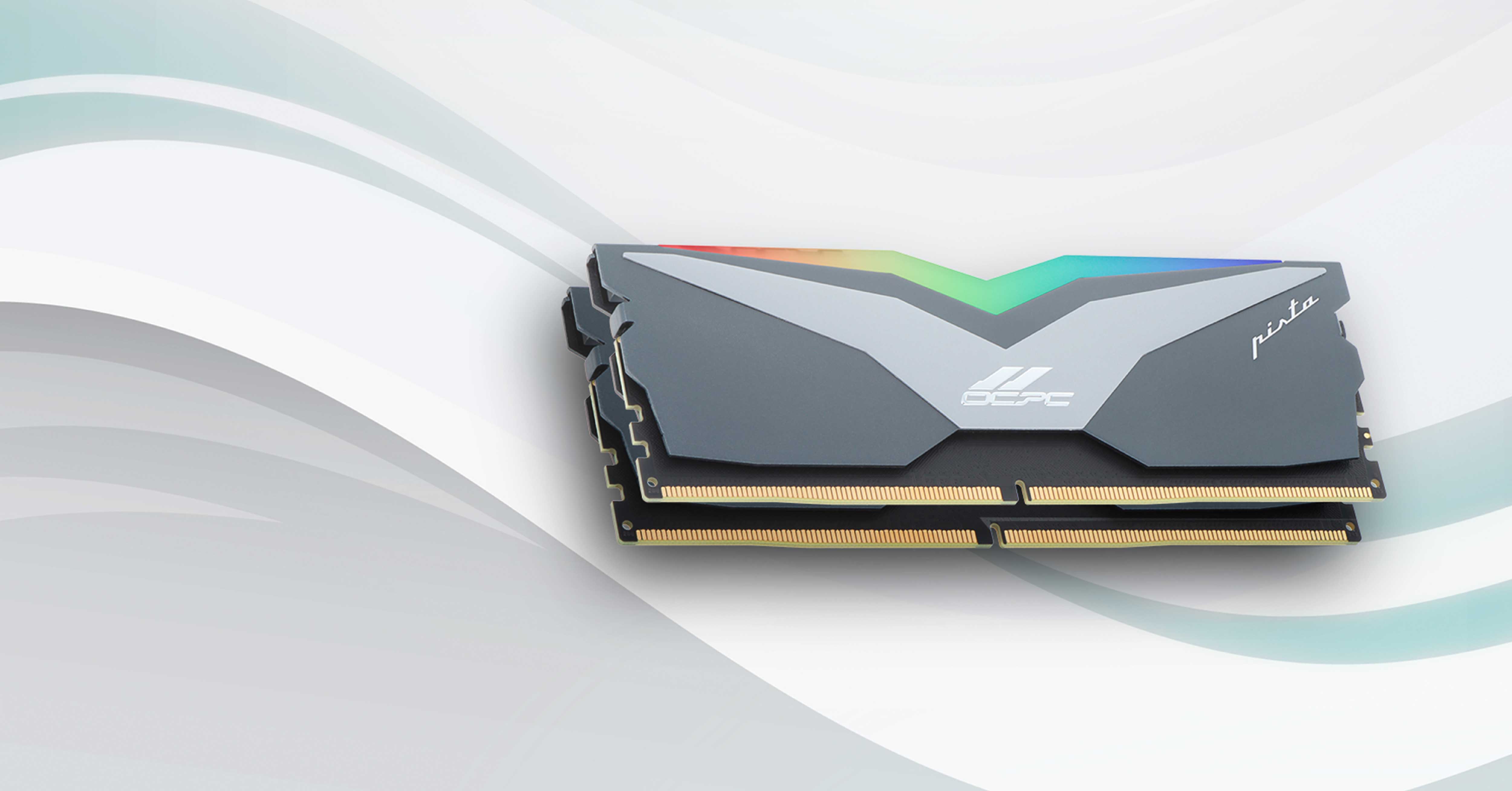HDMI, DVI-D, USB-A, USB-C, VGA, Thunderbolt 3, DisplayPort – so many connection types are available today that the information you need to know can get buried in compatibility charts and product promotions. Instead of going through the surface level details of each of these, we wanted to compile a more thorough look at the capabilities of one important connection type that is popular with content creators, gamers, and professionals alike: DisplayPort.
A Quick Overview
DisplayPort (often styled as DP) is a connection type that provides a transfer of video and audio signals between a host device and a display. Initially, DisplayPort was created with the intention to upgrade preexisting video interfaces like DVI and VGA.
This digital interface is popular specifically for multimedia and TV and is often spoken in the same breath as its more commonplace and arguably more pedestrian counterpart, HDMI. DP is commonly used with desktops, laptops, and projectors.
When it was established in 2006, DisplayPort was originally designed for IT and computing markets for display purposes but is now used in a wider range of applications.
DisplayPort is now known for its reliability and variety of applications, providing high-performance device connectivity for video and audio. Notably among its chief benefits, DisplayPort can pass a video/audio signal beyond a single display and extend to multiple monitors via the same cable connection.
Each subsequent iteration of DisplayPort has centered around the development of the Maximum Data Rate achieved by a DP connection and the monitor resolution achievable with a DP connection. This has occasionally resulted in a jump from one Bit Rate “class” to another. For example, in 2009, DP 1.1 graduated to 1.2, introducing the first 4K at 60Hz monitor resolution, and ushering in the Bit Rate class of HBR2.
The same happened again 5 years later with the introduction of DisplayPort 1.3, bringing 4K at 120Hz or 8K at 60Hz (with DSC), a faster data rate of 25.92 Gbps, and qualifying a new designation: HBR3.
DisplayPort Data Transfer
Data transfer for DP features four lanes running as a packet in one direction. Where other video transmission signals are handled with continuous data transfer, DisplayPort uses fixed rates similar to data transfer seen in Ethernet, USB, and PCI Express.
Transfer Speed & Resolutions
Critical in the determination of color depth, refresh rate, monitor extension capabilities and screen resolution is the transmission speed or bandwidth of the cable. DisplayPort bandwidth competes with the best of cables on the market. Each new iteration of the DisplayPort standard progressed with additional bandwidth, culminating in 77.36 Gbps in the DisplayPort 2.0 specification at UHBR.
In addition to the bit rate class and bandwidth, the chart below indicates monitor resolutions attainable with each DP version.
DisplayPort Version 1.0:
Maximum Resolution - 2560 x 1600 @ 60 Hz
Maximum Data Rate (4 Lanes)* - 5.18 Gbps
Bit Rate Class - RBR/HBR
DisplayPort Version 1.1:
Maximum Resolution - 3840 x 2160 @ 60 Hz or 2560 x 1600 @ 60 Hz
Maximum Data Rate (4 Lanes)* - 8.64 Gbps
Bit Rate Class - HBR
DisplayPort Version 1.2:
Maximum Resolution - 3840 x 2160 @ 60 Hz
Maximum Data Rate (4 Lanes)* - 17.28 Gbps
Bit Rate Class - HBR2
DisplayPort Version 1.3:
Maximum Resolution - 7680 x 4320 @ 30 Hz, 5120 x 2880 @ 60 Hz, or 3840 x 2160 @ 120 Hz
Maximum Data Rate (4 Lanes)* - 25.92 Gbps
Bit Rate Class - HBR3
DisplayPort Version 1.4:
Maximum Resolution - 7680 x 4320 @ 60 Hz (DSC)*, 5120 x 2880 @ 60 Hz, or 3840 x 2160 @ 120 Hz
Maximum Data Rate (4 Lanes)* - 25.92 Gbps
Bit Rate Class - HBR3
DisplayPort Version 2.0:
Maximum Resolution - 15360 x 8460 @ 60 Hz (DSC)*, 7680 x 4320 @ 60 Hz (4:4:4, HDR10), 3840 x 2160 @ 144 Hz (4:4:4, HDR10)
Maximum Data Rate (4 Lanes)* - 77.37 Gbps
Bit Rate Class - UHBR
DSC (Display Stream Compression) is a form of visually lossless compression for ultra high definition displays designed to reduce the bandwidth demand on the links between devices. Display Stream Compression was first introduced in DisplayPort Version 1.4.
DisplayPort Features In Action
Using the DisplayPort Alt Mode feature of USB-C and the MST capabilities for DisplayPort the following VisionTek Docking Stations allow output to multiple High Definition Displays.
VT200 Dual Display USB-C Docking Station with Power Passthrough
Expand up to 2 x 1080P Displays
VT400 Portable USB-C Docking Station with Power Passthrough
Expand up to 2 x 4K Displays
VT2000 USB-C Docking Station - Multi Display MST Dock
Expand up to 2 x 4K Displays
DP vs. HDMI
When comparing video signal cables, the DisplayPort or HDMI question is frequently asked. At the end of the day, both cable types offer similar results, though each is known in the tech community for different use cases.
Primary Differences
DP is regularly seen as the go-to for professional or commercial uses, whereas HDMI is regularly used in consumer-centric devices. This distinction is doesn’t stretch to all consumer products, however, as some devices like graphics cards and high-end displays are frequently outfitted with DisplayPort connections.
MST & Daisy Chaining
After the release of DisplayPort 1.2, a new transmission mode became available known as Multi Stream Transport Mode (MST), making it possible to connect to a number of displays through a single DP connection. This feature, known as daisy-chaining, distinguishes DisplayPort in that HDMI is only capable of driving a single display per cable. HDMI, however, offers an Audio Return Channel (ARC) that provides sound to the source device from a display, which is a feature absent in DisplayPort cables.
An alternative to daisy-chaining is to use a DisplayPort MST hub. In these cases, the number of connected displays is simply limited by the data transfer rate of your DP interface.
Physical Features
Apart from these data-related differences, the only other key differences between the two types are the physical connector shapes – with DisplayPort offering a smaller rectangular connector compared to HDMI’s trapezoidal attachment – and the inclusion of a latching mechanism in many DP cables that prevents disconnection from the source device.
DP Alt Mode
As more and more smartphones and tablets are incorporating USB Type-C connectors and ports, the need for an alternative mode for transferring DisplayPort signals was required. Enter DisplayPort Alt Mode for USB Type-C. With this standardization, devices that support DP Alt Mode can carry a DisplayPort signal through a USB-C port.
Dual Mode DP (DisplayPort ++)
On a basic level, this connection allows for DisplayPort compatibility with signal types DVI and HDMI, which are found more frequently on legacy, economy, or consumer-focused devices.
In order to connect to HDMI, DVI-D and VGA, an active adapter is required.
All DisplayPort cables are compatible with all DP devices, regardless of the version you’re using.
Also, unlike some other connector types, DisplayPort cables have no specified cable length limit, meaning ultra-long cables can be found for sale. Additionally, DP requirements include an HBR2 minimum speed (21.6Gbits/s) for all cables up to 2 meters in length.
Find our collection of DP Cables & Adapters here:
DisplayPort Cables & Adapters
Mini DisplayPort
Designed for smaller devices and Apple-released products, Mini DisplayPort (frequently styled mDP) is functionally no different from its classic DP counterpart in terms of performance and capabilities, it simply uses a different connector type in a smaller form factor.
For example, Thunderbolt 2 ports on Apple products feature the ability to connect mDP cables, as the ports were the same shape, though the two connection protocols are different. With Thunderbolt hosts welcoming DisplayPort technology, DP has seen an accelerated use in display-centric computing such as video editing.
Find our collection of Mini DisplayPort Cables & Adapters here:
For more information about DisplayPort, or answers to questions not addressed in the guide above, check out DisplayPort’s FAQ page, found here: https://www.displayport.org/faq/





Share:
Understanding the Resolutions and Display Capabilities of the VT2000 & VT2500
Which Docking Station Is Right For Me?